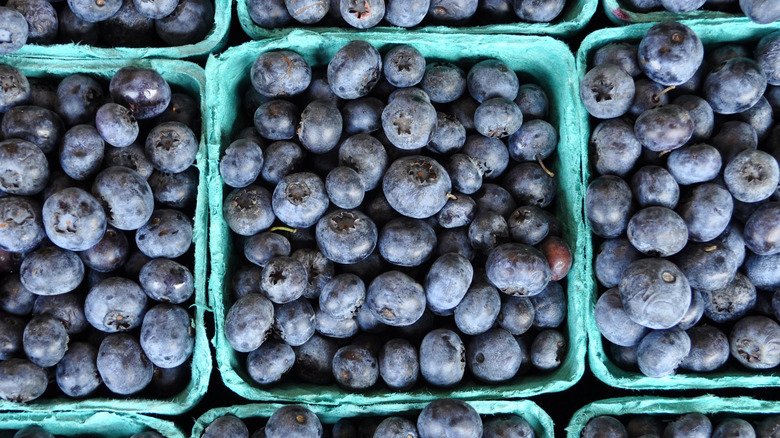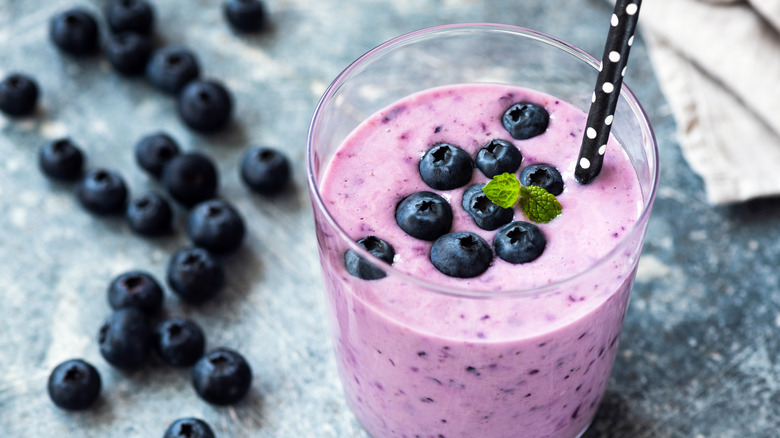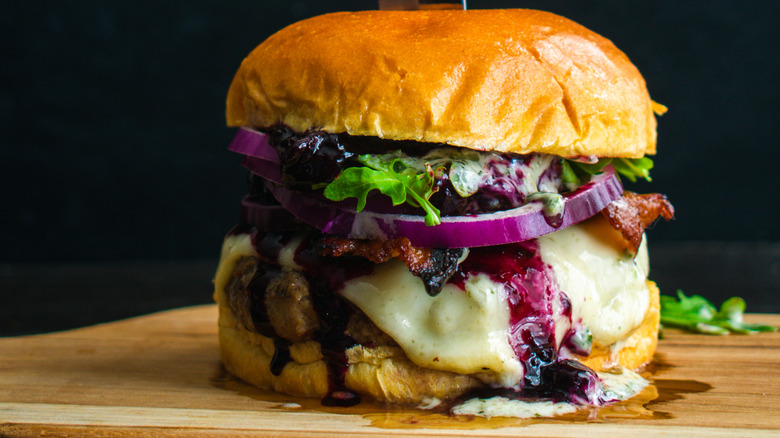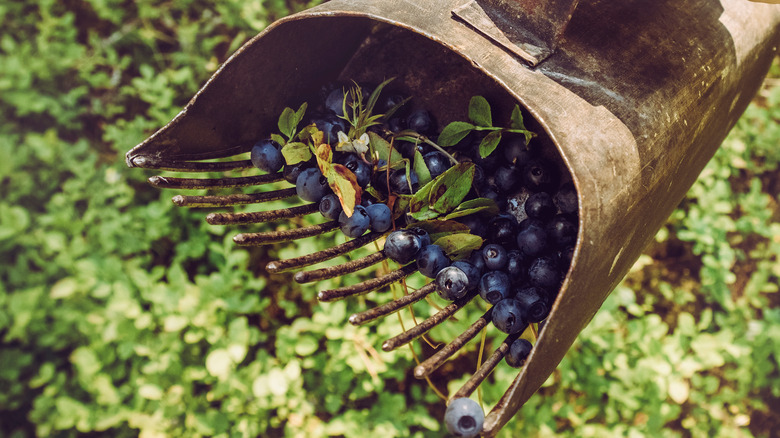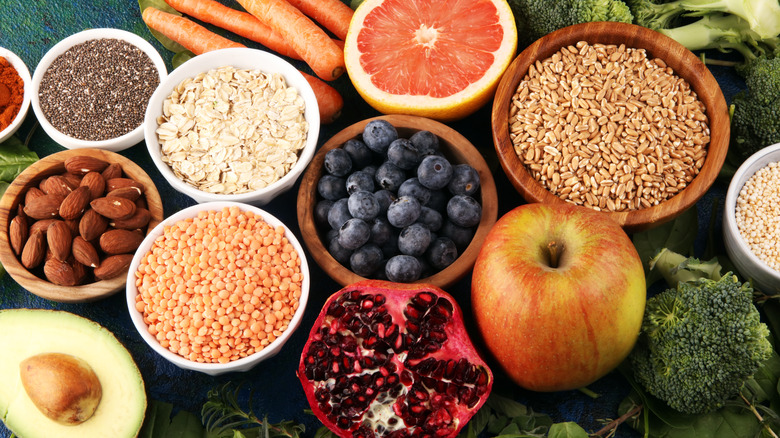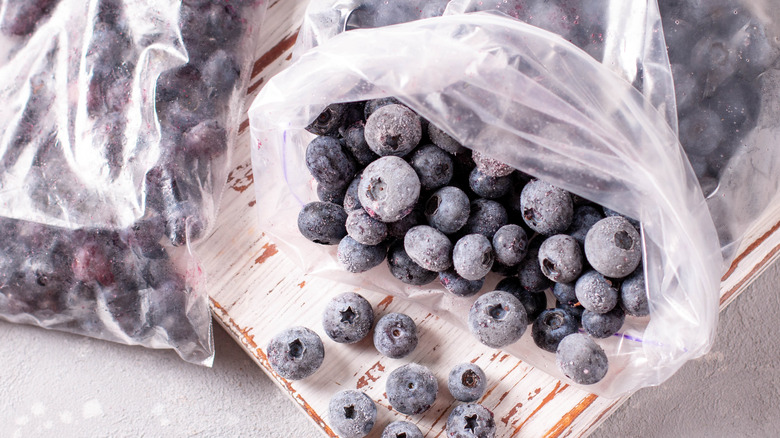Everything You Need To Know About Blueberries
Blueberry pancakes, blueberry muffins, blueberry smoothies, blueberry pie. Blueberries are everywhere, and that's the beautiful thing about them! They have a starring role in so many baked goods and fresh fruit dishes and are easy to find fresh or frozen, even out of season. Blueberries are so ubiquitous that you've possibly never stopped to wonder where they come from, how they're grown, or even what varieties might be available. We have everything you need to know about blueberries here.
The Spruce Eats shares that blueberries — small, round fruits that grow on bushes — are native to North America. Unripe berries are green when they first develop, then turn pink before ripening to their final, familiar, blueish-purple hue. Healthline says that blueberries are in the same family as huckleberries and cranberries. According to the The Old Farmer's Almanac, there are four types of blueberry bushes. The most common one, bred to grow in several climates and whose berries end up in stores, is the tall highbush (Vaccinium corymbosum). The other types are lowbush, half highbush, and rabbiteye.
Blueberries are tough shrubs: They survive the frigid winters of the North, rabbiteye types thrive in the heat of the southeastern U.S, and Burpee says that blueberry bushes live for as long as 50 years. The Old Farmer's Almanac also shares that cultivated blueberries have only been available for the last century or so; prior to that the only way to get blueberries was to find and pick them in the wild.
What do blueberries taste like?
The flavor of blueberries can be hard to describe! Users on Reddit tried, and came up with "deliciously sweet", "blueberryish", and "blue." More helpfully, Thrive Cuisine describes the flavor of blueberries as comparable to a cross between red and green grapes: Sweet, but also with a bit of acidity and even tartness depending on ripeness and the variety. They also share that since blueberries stop ripening once they're picked, you can try leaving them on the bush for an extra day or two so they get as sweet as possible. (However, be warned that birds and other critters won't hesitate to steal them from you.)
This is just a flavor snapshot of fresh blueberries, but there's also the flavor of cooked blueberries, made into sauces and jams, or baked into sweet treats. Slate shares that when heat breaks down the cell walls of fresh blueberries, the fruit sugars are released, as well as the pigments that give blueberry fillings that gorgeous reddish-purple color. The berries become sweeter and the flavor intensifies.
Blueberries pair well with many other flavors and foods, which makes them extremely versatile. The Baker's Almanac shares that blueberries are delicious with dozens of other fruits like lemon and mango, spices like cinnamon and lavender, sweet maple syrup, and creamy ingredients like mascarpone cheese. Not to mention, they also taste delicious with savory ingredients like grilled meats and hot sauces (via Flavor & the Menu).
How to use blueberries
Like we said, blueberries are really versatile and play well with many flavors. You can easily enjoy blueberries in every meal of the day, plus in snacks and drinks! Fine Cooking suggests the minimalist approach, to enjoy the unadulterated flavor of the berries. Eat fresh blueberries, especially ones that have just been picked, right out of the box. The outlet also recommends consuming blueberries in simple cooked dishes, like crumbles and pies, with just a dash of flavorings or spices.
The Spruce Eats says blueberries make for tasty twists on classic cocktails like martinis, sangria, and cosmos. Everyone loves a good blueberry pie, but there are hundreds of other blueberry dessert recipes, such as cheesecakes, ice cream, trifles, tarts, and bars (via Taste of Home). There plenty of ways to start the day with blueberries for breakfast, and not just in fruit salads. Eating Well shares that some of their favorite blueberry breakfasts include overnight oats, smoothies, and classic muffins. (These would also make fantastic midday snacks.) Heck, you can even start the day with a cup of blueberry coffee.
One way that blueberries are sometimes overlooked is as a unique ingredient in savory dishes. The U.S. Highbush Blueberry Council suggests using blueberries for sweet-spicy sauces, with meats, in salads, and in homemade ketchup. And for something really different, try the Pickled Blueberries from Food52. They have a tangy, herby punch thanks to wine vinegar and rosemary.
What are wild blueberries?
Wild blueberries also go by the name of Maine blueberries, because these tiny specimens are Maine's official state fruit (via the Maine Office of Tourism). Wild blueberries are a lowbush type, as opposed to the larger, highbush blueberries that are typically sent to produce aisles. The Wild Blueberries Association of America shares that wild blueberries are tinier, and different varieties grow together, which gives them a unique flavor profile. According to Bangor Daily News, wild blueberry bushes grow as a low groundcover. They thrive in rough terrain and survive Maine's subzero winters.
Tiny, wild blueberries are a favorite not only for their more intense flavor but also for their health benefits. Bangor Daily News shares that wild blueberries have the advantage of containing higher levels of beneficial antioxidants, which are found in the dark pigments in the berry skins. While all blueberries have these pigments in the skins, wild blueberries have a higher ratio of skin to pulp.
The Maine Office of Tourism encourages visitors to enjoy wild blueberries from local growers, in the baked goods of Maine bakeries, and at its annual Wild Blueberry Festival. However, if you aren't heading up that way anytime soon, check grocery stores for frozen wild blueberries from producers like Wyman's.
Blueberries are very good for you
According to Healthline, blueberries are a low-calorie food: A half cup serving has only 52 calories plus a small amount of fiber, and the sugar content is low enough that blueberries are safe for diabetic diets. Blueberries are also a great way to get more vitamins and minerals, especially vitamin C and vitamin K1.
There are more reasons that blueberries are touted as not only healthy but as a superfood. Eat This, Not That! shares that eating blueberries daily helps heart health by lowering levels of triglycerides in the blood. Blueberries can also help lower blood glucose. People with diabetes often eliminate fruits to control sugar in their diet and their insulin levels, but blueberries are a fruit that they can actually continue to safely enjoy.
The superfood status of blueberries is also tied to their high levels of antioxidants. The Mayo Clinic says the antioxidants in blueberries, called anthocyanins, are present in the blue-purple pigments in blueberry skins. The Atlantic reports that the antioxidants in blueberries have been found to improve brain function and reduce blood pressure. And if you're looking for another reason to choose wild blueberries over cultivated ones, the Wild Blueberries Association of America reports that tiny, wild berries have more antioxidants — more than larger blueberries and more than fruits like raspberries and pomegranates.
Buying and storing blueberries
When it comes to getting your hands on some blueberries, fortunately, that's pretty easy to do. At the grocery store, check the produce aisle for clear clamshell containers or berry baskets of blueberries. Choose berries that have no signs of mold, shriveling, or leaking juices (via U.S. Highbush Blueberry Council). Wait to wash them until just before you plan to eat or use them, and store them in the fridge for about a week. Do the same with freshly picked blueberries that you pluck yourself or find at farmer's markets and local berry farms (via PickYourOwn.org)
You can also freeze your fresh blueberries. Start with clean, dry berries spread in a single layer on a tray, then place the tray in the freezer. Once frozen, transfer the berries to freezer-safe bags with all the air pressed out, and store them for up to six months. You can also find frozen blueberries in the aisle where other frozen fruits and frozen desserts are located. Freezing your blueberries is a great way to have them on hand anytime you want to toss them into muffins or cook them into a rich barbecue sauce.
Dried blueberries are another way to keep this fruit stocked, and they'll be on the shelf with other dried fruit like cranberries and raisins. Food52 users say to use dried blueberries in recipes the same way you would raisins. Eat them as a snack or toss them with granola or cereal.
